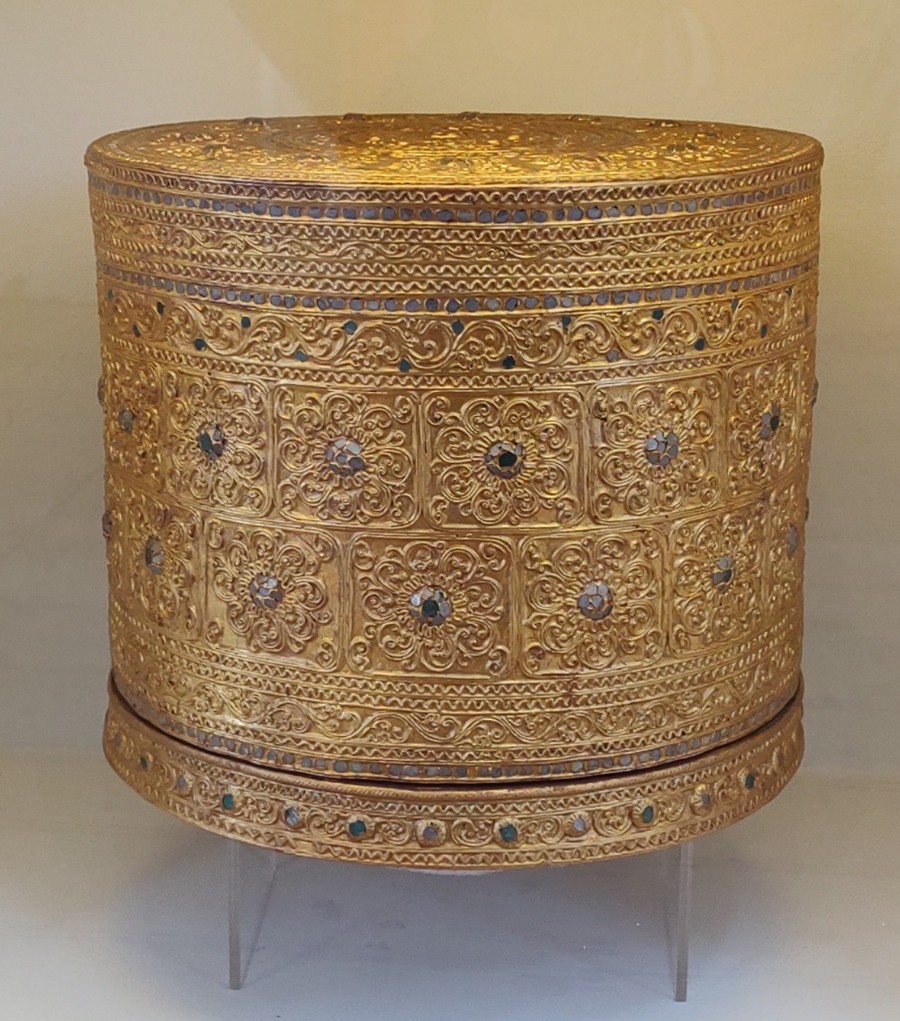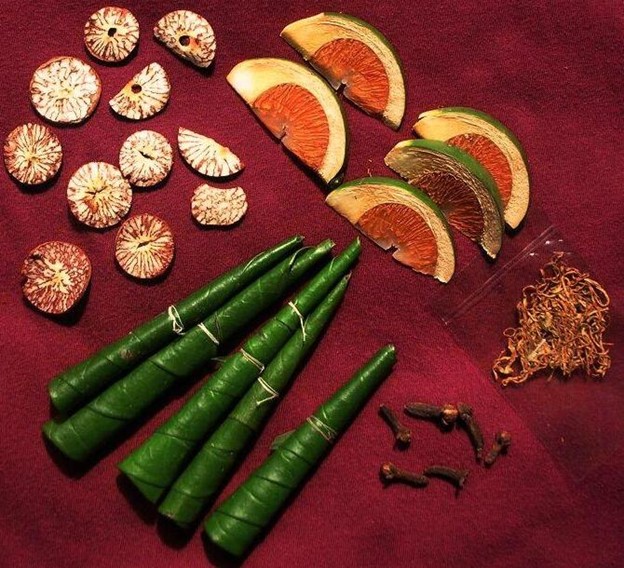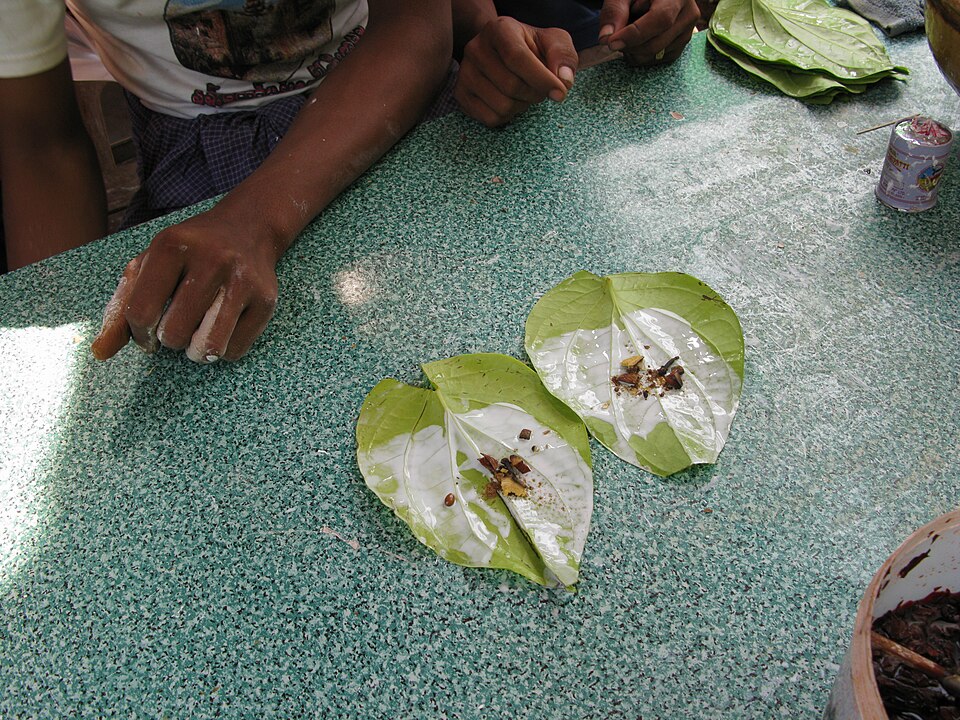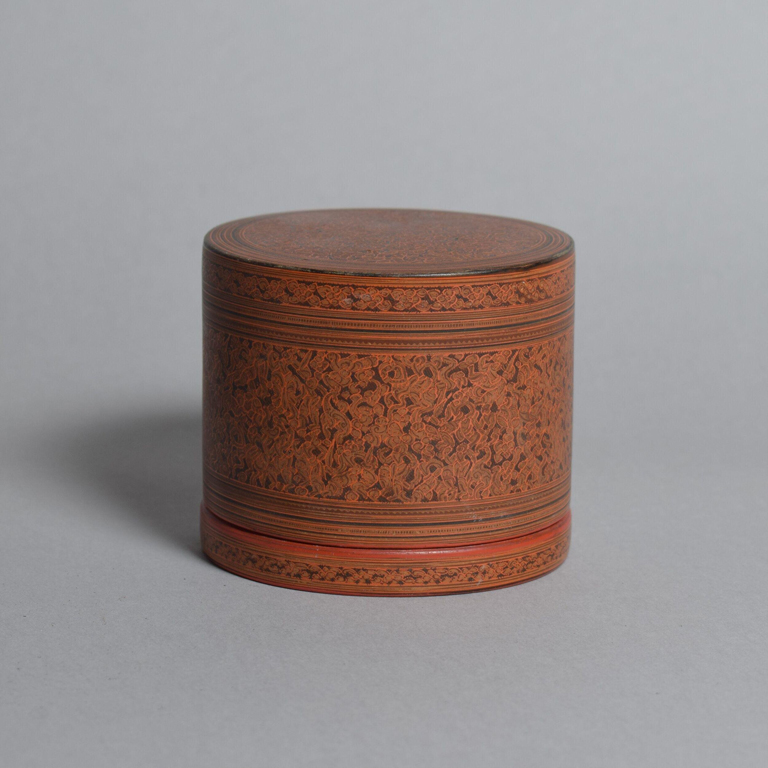A Betel Box or just a box?
Last spring we began auditing part of our World Art Textile Collection.
The collection includes all non-Western textiles and accessories, with a great number of Burmese and African pieces. During the audit we encountered beautifully elaborate textiles like Burmese Court Dancers costumes and Kimonos embroidered with golden landscapes.
A few weeks into the project, we came across a plastic box labelled “Box for hairpiece” with a beautiful cylindrical container inside. It was surprisingly light, yet it deceived the eye, gilded and decorated in great detail with flower petals and mirrored glass mosaic pieces. It had a lid with an illegible word inside, perhaps a signature, and a nesting tray.
There was a strong scent coming from within as we opened it. The interior had the characteristic red colour of Burmese lacquerware, which comes from finely ground cinnabar. Upon searching other museum and auction house databases, we came across betel boxes of similar size and structure. However, we struggled to find examples that were as ornate as this one, which has been gilded and inlaid with beautiful small pieces of mirrored glass forming what looks like a six-petal flower.
Betel boxes are used for storing ingredients for betel chewing.

Betel chewing
Betel chewing has a very long tradition in Myanmar (formerly Burma), having been practised since before the beginning of recorded history. Betel nut chewing originates from Southeast Asia, which is native to the plant ingredients. The name comes from the betel vine leaves that are used to wrap the areca nut from the Areca palm, then chewed together.
Historically, both men and women would chew it. Every household would have a special lacquerware box called kun-it, which would be offered to any visitor alongside cheroots to smoke and green tea to drink.
Betel boxes
The betel vine leaves are kept at the bottom of the box, and there is a top tray for small tins, usually made of silver in wealthier homes. The tins house various other ingredients such as the betel nuts, slaked lime, anise seed and other spices, which vary depending on geographical areas.
It can sometimes include other substances for flavouring and to freshen the breath, like coconut, dates, sugar, saffron, cloves, cardamom, and many others. The preparation combining these ingredients is known as a betel quid called paan in South Asia which translates to “wrap”. Its chewing is a widespread social practice in Southeast Asia, Micronesia, and Melanesia.

The consequences of betel chewing
It can be a stimulant, but also have narcotic effects, the primary psychoactive compound being arecoline. The preparation is not swallowed but is spat out after chewing. Chewing results in permanent red stains on the teeth after prolonged use. It is used by almost a tenth of the world’s population, some of them are women and children. It is especially a popular habit among working-age men, who use it to stay awake through long shifts of labour.
Betel nut chewing has become negatively associated with the working class and the least privileged communities in society, widening the gap in the social class system. The spit from chewing betel nut results in red stains on pavements and roads, so it is often regarded as unhygienic and an eyesore.
Medical studies suggest that betel nut chewing is now known to be addictive and the cause of adverse health effects, mainly oral and oesophageal cancers, but also cardiovascular diseases.

Because of the long-lasting tradition of betel nut chewing within the Burmese population, lacquered betel nut boxes were a common house accessory and were often gifted.
Lacquerware making
Lacquerware making is a prominent art in Southeast Asia and is one of Burma’s (Myanmar) traditional handicrafts —handmade from start to finish, —known to have existed since the Bagan Period (AD 11th to 13th centuries). The skill is passed down to new generations preserving the historic craft. Burmese families prided themselves on their lacquerwork. The process-making of lacquerware objects is lengthy and simply extraordinary.

Bamboo strips are woven to create the desired form, for larger pieces, wood, and cane are also used. The pieces are characteristically thin and lightweight. Raw materials are sourced locally and transported via the Irrawaddy River.
The lacquer paste is then applied by hand onto the mould following a rigorous procedure. Once the first layer is finished, the piece is left dry in a dark and humid place for about a week. When dry, the piece is washed and sandpapered in preparation for the next lacquer layer. This process is repeated at least seven times, as that is the minimum number of coatings required to be considered a “good” quality piece.

Our betel box
Unfortunately, we don’t have much provenance information about the betel box found in our World Art textile collection yet. But its design suggests that the box may have come from the Shan states in eastern Burma (present Myanmar) or been made by a Shan craftsman.
We estimate that it was made circa 19th Century. Burmese betel boxes held in other museum collections are usually only lacquered, sometimes then incised creating unique designs like storytelling landscapes. It is rare to come across an example like this where gilt was also used. Initial research suggests that gilded betel boxes of this type often were commissioned as presentation pieces, for one prince to give to another, or perhaps to present to an esteemed monk. Or perhaps it is just a box for a hairpiece after all.